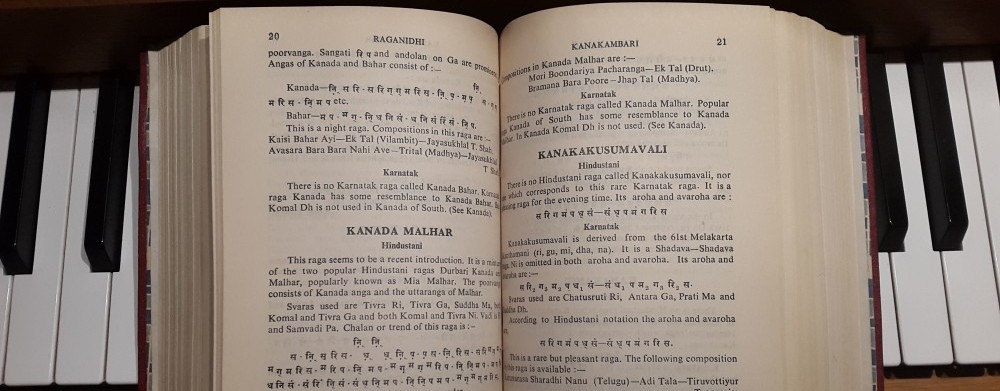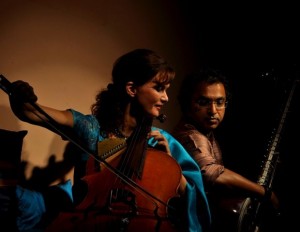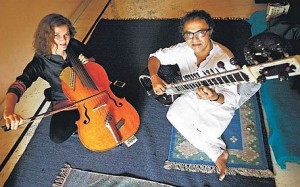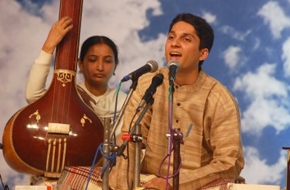Early September 2012 I heard (and met) Italian dhrupad singer Amelia Cuni in Göttingen, where she did a concert titled Cosmopolit@n Ragas. It was a beautiful musical event in two parts, starting out with Amelia Cuni’s performance of a raga in traditional dhrupad style. Then she took things in another direction by presenting her dhrupad-styled improvisational skills in a very different musical framework: she performed John Cage‘s Solo for Voice 58: 18 Microtonal Ragas. Here I like to share a beautiful recording of Amelia Cuni interpreting this work of John Cage. Enjoy!
Tag Archives: raag
Great 1965 recording of the (Senior) Dagar Brothers – Raga Desi
N. Rajam’s great ‘gayaki’ on violin – Raag Malkauns
Violin icons of East & West meet up: Kala Ramnath and Hilary Hahn
A meeting up of world famous violin players from different classical traditions is not an evryday phenomenon. Recently it happened to Hindustani classical (raga) performer Kala Ramnath and Western classical player Hilary Hahn. Kala wrote a piece for Hilary and in this video she explains a few basics of raga music and about the piece she’s done for Hilary.
Wonderful concept for an enhanced experience of raga music: The Silence Concert
To help people experience the power of Indian classical music, married and musical couple cellist Saskia Rao de Haas and sitarist Shubhendra Rao started the Silence Concert movement, to experience music in its purest form: surrounded by silence. An intriguing, fascinating concept.
Saskia and Shubhendra explained their initiative in The Hindu of 19 September 2012 and here’s what they have to say about it on the Silence Concert Facebook-page they created:
“What is a Silence Concert?
For the sensitive listener, there can be a big difference in attending a concert and experiencing music. The effect that music can have on our lives, especially Indian music, is often lost by the social conventions that prevail at concerts: applause, talking before and after the concert, ceremonies, all of which take the attention away from the music itself. To help people experience the magical power of Indian music in a concert setting, Pt Shubhendra Rao and Saskia Rao initiated the Silence Concerts movement. In a Silence Concert the only sound that reverberates is music. There are no introductions, ceremonies, gimmicks, talks, speeches or applause. The setting is serene, beautiful and set up to experience beauty within through the pure experience of music. Through controlling external influences that can distract listener and performer the experience of pure music is enhanced.
Entering the auditorium for a Silence concert, the audience and artists leave behind their worries and daily masks, because they do not have to respond in word or gesture to the outside world. They can be gently led through a sublime journey within. What follows is that their experience turns within. The artist can share his music without playing to the gallery and the effect lingers after the concert, not interrupted by applause.
Abhinavagupta (approx. 950-1020 AD), the Indian philosopher, said that the ‘perfect audience is a spotless mirror of the performer’. Audience and performer become one in a Silence concert. The social context is taken out and the audience is left with a truly introspective experience, as is the performer.” (Saskia Rao de Haas and Shubhendra Rao)
Saskia and Shubhendra end with a quote of Sufi Inayat Khan (1882-1927):
“While tuning the tanpura, the artist tunes his own soul. Not only has he tuned the instrument, but he has felt the need of every soul in the audience and the demands of their souls, what they want at that time. He becomes an instrument of the whole cosmic system, open to all inspiration at one with the audience, in tune with the tanpura and it is not only music, but spiritual phenomena that he gives to the people…‘ The object of Indian music is the training of the mind and the soul, for music is the best way of concentration. If one only knows how to appreciate it and give one’s mind to it, keeping all other things away, one naturally develops the power of concentration. Besides the beauty of music, there is the tenderness, which brings life [and gratitude] to the heart. For the person of fine feelings life in this world is very trying. It is jarring and it sometimes has a freezing effect. It makes the heart, so to speak, frozen. If one can focus one’s heart on music, it is just like warming up something that was frozen. The joy of life depends upon the perfect tuning of mind and body.”
Perhaps new opportunities for raga playing… pianists?
For those who (keep trying to) play ragas on a piano – but do they play ragas? I don’t think so – perhaps for them this ‘fluid’ piano opens up new opportunities in regard to the use of different tunings, but also in regard to pitch shifting or bending the notes during playing. 🙂
Membership Raga Unlimited more than doubled in 2011
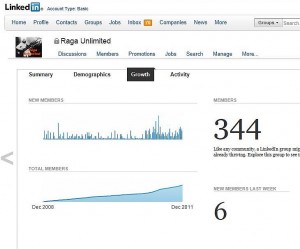 Raga Unlimited growth rate figures (click on picture to enlarge)
Raga Unlimited growth rate figures (click on picture to enlarge)
The LinkedIn-group that I run, Raga Unlimited, launched on 12 December 2008, has now 344 members. Anyone interested and registered on LinkedIn can join, that is, after (my) admission (don’t worry, there have been no refusals so far). A lot of knowledgeable people show up in the ranks. 37% works in the music industry and 16% is active in arts & design. In 2011 the group’s membership figure more than doubled, from 150 to 343, that’s an increase of 193 members in one year. Most people joined in May (28x), June (29x) and December (29x). Today, New Year’s Day 2012, I’ve already welcomed one more newbie, so we’re talking about a membership growth rate of 1 per day so far this year :).
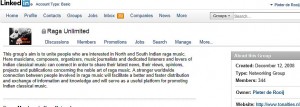
The group’s ‘mission statement’ (click on picture to enlarge)
Feel free to join if you’re interested.
Raga Unveiled – ambitious cinematic effort to grasp the essence of Hindustani classical music
I reported earlier on ‘Raga Unveiled’, an ambitious cinematic effort to take a look at the history and essence of the Hindustani classical music system. In this film – directed by Gita Desai and released in 2009 – scholars and great artists of today unveil the raga and demonstrate evrything you always would have liked to know about Indian classical music.
Here’s the trailer:
For anyone interested in raga music this 260 minute-film is a ‘must’ and of course it’s needless to say that you should see and buy the film on dvd in much better quality.
In the footsteps of Kumar Gandharva – ragasinger Pushkar Lele tours Holland & Belgium
A not to be missed concert tour of young ragasinger Pushkar Lele in The Netherlands and Belgium from 30 November to 6 December 2011. Pushkar Lele sings in the North Indian hindusthani tradition. Natural curiosity led him to follow in the footsteps of that great innovator of Indian vocal music, Kumar Gandharva. No imitator, however, he performs his own interpretations of ragas and bhajan poetry. Pushkar Lele’s vocal art will be accompanied by Sanjay Deshpande on tabla and Suyog Kundalkar on harmonium.
Tour schedule:
Antwerpen – Zuiderpershuis 30 nov. 20:30
Utrecht – Rasa 1 dec. 20:30
Amsterdam – Tropentheater 2 dec. 20:00
Den Haag – Regentes – 4 dec. 03:00 PM
Maasmechelen – Schouwburg Cultureel Centrum – 6 dec. 20:15
Shankar Tucker conquers a world audience via YouTube
I’ve been tracking down his uploads ever since I noticed his presence on YouTube early this year. Shankar Tucker is quite a phenomenal guy who has conquered a world audience by storm via his YouTubechannel in less than a year.
One of Shankar Tucker’s videos: Sapnon se Bhare Naina, with singer Rohini Ravada
Shankar Tucker plays the clarinet and a handful of other instruments and is interested in Indian Classical music and Indian folk music traditions. He incorporates these different styles with elements of Jazz, Electronic, Classical and Pop in his compositions. He spends a lot of time in India, where he studies Hindustani music on clarinet with flute-bansuri player Pt. Hariprasad Chaurasia. So far Shankar Tucker’s channel has featured collaborations with a bunch of great singers, such as Mahesh Vinayakram, Aditya Rao, Rohan Kymal, Vidya and Vandana Iyer and Nirali Kartik.
Here’s a link to the Hindustan Times writing about him in September 2011, a.o. things saying: “(..) a student of flautist Pandit Hariprasad Chaurasia at the Brindaban Gurukul in Mumbai, he has picked the clarinet over flute”. And then, so funny what follows: “(..) he disclosed in an interview to an Indian Express that his guru doesn’t even know about his fusion experiments.” :))
